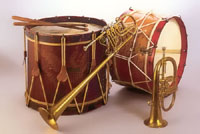
OVERVIEW of CIVIL WAR ARMY MUSICIANS
by Mark Konya, Chief Musician
8th MO Infantry (US) Re-enactors
The period April, 1861 to August, 1862 could be referred to as the regimental band period.
It is a time when hundreds of bands (and bandsmen) were mustered into service with volunteer regiments.
These bandsmen were paid solely to provide military music; they were considered non-combatants
and were not generally required to perform duties outside of those associated with
their musical responsibilities.
By the end of 1861, the Federal government began to experience a strain on its finances
and commenced searching for ways to save money. It soon realized that permitting volunteer
regiments the luxury of a band containing as many as 24 musicians was not affordable.
The first order adversely affecting regimental bands was issued by the War Department in October, 1861.
This order forbid mustering in new regimental bands and prohibited enlistment of bandsmen to fill
vacancies. It also directed that all members of bands who were not musicians be discharged.

In 1862 regimental bands were disbanded (No pun intended!) Brigade bands were authorized
in their place, drawing on competent musicians taken from the ranks. These musicians continued
to appear on company rolls, but served at the brigade level.
One reason for the reorganization was that the
cost of maintaining a large number of bands (which swelled in response to Lincoln's call for troops)
was deemed too great. Of course, there was a great deal of grumbling in response to
the reorganization. Some regiments even found ways to circumvent the new regulations
and keep their bands.
The major blow to regimental bands came in July, 1862 when the War Department issued
General Order No. 91 directing that all regimental bandsmen be mustered out of service within 30 days.
Musicians who were recruited from infantry companies to serve in bands were ordered to be transferred
back to their units. Bandsmen who had been mustered in as musicians were to be discharged,
or, with their own consent to be transferred to brigade bands. Thus, General Order No. 91
significantly reduced the number of bands in the Federal Army.
This reorganization probably accounts for the "dual nature" of the information about
the 8th MO musicians.
To round out an overview of Army music, it is also helpful to
understand that regulations authorized each company one fifer and one drummer.
These were field musicians, which, when combined with other companies, became a regimental drum corps.
At full strength, this corp consisted of 20 musicians (10 fifers and 10 drummers) under the
leadership of a drum major (usually a non-commissioned officer holding a rank commensurate
with that of sergeant-major.) The basic field music organization remained unchanged
throughout the war. It was also a distinct and separate organization from the regimental
(or later) brigade band.
Most of the above information comes from "A Pictorial History of Civil War Era Musical Instruments and Military Bands" by Robert Garofalo and Mark Elrod. Also cited is one of the best primary sources for field music information: "The Drummers' and Fifers' Guide" by Bruce and Emmett.